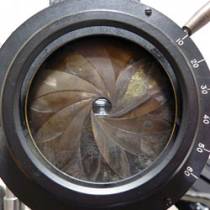
2010
| MP3-192kbps
| Wandering Ear
| we014
[Abstract,
Experimental]
Tracklist
| 1 |
|
Overture
|
|
|
| 2 |
|
Film Projection
|
|
|
| 3 |
|
24bps
|
|
|
| 4 |
|
Slideshow
|
|
|
| 5 |
|
Television Monitor
|
|
|
| 6 |
|
Video Projection
|
Oculus investigates the acoustic properties of visual art display
mechanisms, combining field recordings and synthesized sound. Beginning
as a series of field recordings made in museums and galleries during the
summer of 2009, this audio collection coalesced into a fascinating
document of sounds that are often ignored or considered superfluous. Can
visual information be described by the sound of its display? Are these
sounds and their corresponding images mutually exclusive, or symbiotic?
What happens when the background is separated from the foreground - does
it merely leave a gaping hole, or create a new object with its own
relationships and contexts to explore?
Track 01 - Overture (9.25MB)
A statement of the
primary source material and themes appearing in the tracks that follow,
the Overture begins with a manipulation of the recording of the
electromagnetic field generated by an analog television monitor from
track 5, then goes on to present four untreated field recordings mixed
with synthesized sound derived from the material in track 3. The field
recordings are, in order: a slide projector in the Michael Snow room,
Art Gallery of Ontario; film projectors in an installation by Wolfgang
Plöger, Art Institute of Chicago; television picture tubes in an
installation by Iain Baxter&, Art Gallery of Ontario; and a video
projector from an installation by Immony Men, Art Gallery of Windsor.
Track 02 - Film Projection (10.6MB)
A combination of two
field recordings bookending a digitally processed drone composition
using the field recordings as its source material. In order: Film
projector in a Henrik Hĺkansson installation at The Power Plant Gallery,
Toronto; film projector showing Laszlo Moholy-Nagy's "Lichtspiel
Schwarz-Weiß-Grau” with audience applause, Paradiso, Amsterdam.
Track 03 -
24bps (4.26MB)
The only purely
synthesized piece in the collection, 24bps is a series of tones played
at the rate of 24 beats per second, analogous to the 24 frames per
second standard of traditional film projection - a bridging of analog
and digital sonic worlds.
Track 04 -
Slideshow (9.18MB)
A synthesized drone
created using analog synthesis techniques permeates the track, a tone
whose aesthetics echo a time when slide projectors were the de facto
standard for still image display in the art world. Processed samples of
the slide projector from the Michael Snow field recording in the
Overture are placed 27.2 seconds apart - the mean time of how long the
average visitor spent looking at a piece of art during a 2001 study at
the Museum of Modern Art, New York. Mixed in at low volume is a field
recording of visitors in the Masterpieces show on display at the
Rijksmuseum, Amsterdam. In combination, an impossible sound world based
on a scientific fact.
Track 05 - Television Monitor (9.32MB)
Using an analog
television monitor as the source material, this piece begins with drones
created by manipulating the speed of a recording of the electromagnetic
field of a television. The recording shifts to an untreated version of
the recording of the powering up of the monitor, then eventually shifts
to a heavily processed version of the Iain Baxter & recording from
the Overture, stripping away much of the low end to focus on the
high-pitched buzz and whine of the multiple picture tubes.
Track 06 - Video Projection (10.3MB)
This track focuses on the
sound of video projection systems and includes a processed recording of
the audience watching a video projection installation by HC Gilje at
NIMk in Amsterdam, processed recordings of the electromagnetic field of a
video projector in my studio, and the sound of a video projector in use
at the Art Gallery of Windsor, Ontario. The electromagnetic projector
recordings here have been processed using convolution, applying the
acoustic space of the Windsor video projector recording to drastically
alter their original timbre and place them in a non-existent,
non-idealized sonic space.
